Chausath (64) Yogini Hindu Temples Architecture
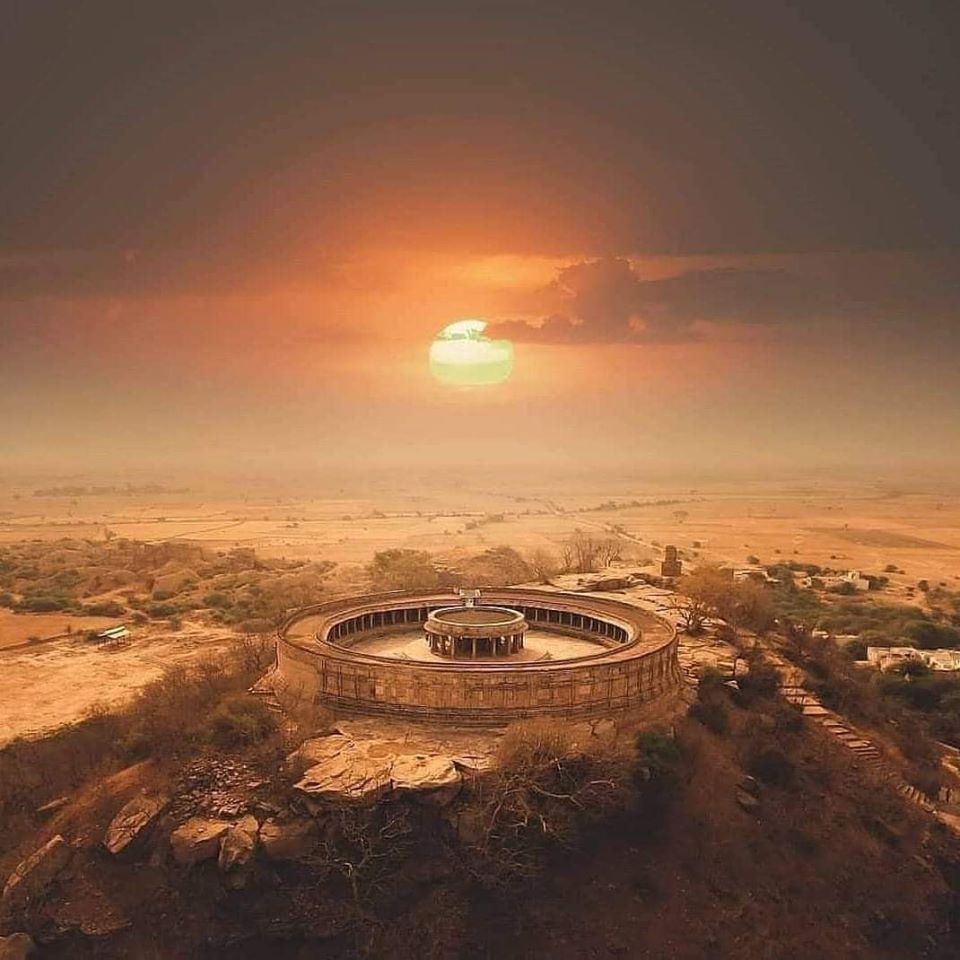
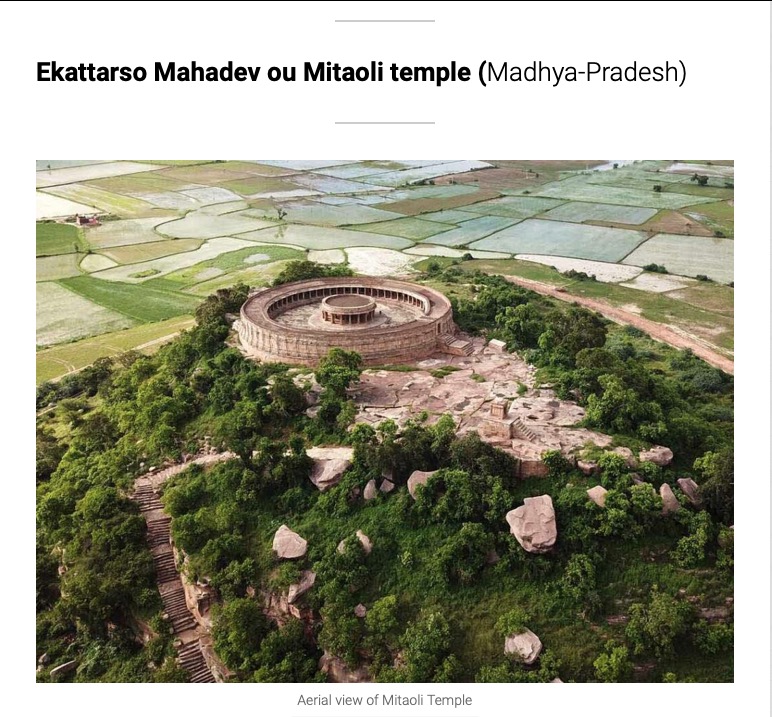
Key Terms
- Tantra
- 64 Yogini
- Chausath Yogini
- 56 + 8 = 64
- 8 – 16 (8 x 2) – 64 (16 x 4)
- 8 x 8 = 64
- Bhairav
- Kali Maa
- Durga Maa
- Sapta Matrikas
- Ashta Matrikas
- Nav Durgas
- Dasa Mahavidhyas
- Shodashi Nityas
- Shodashi Durga
- Shodashi Gauri
- Shodashi Lakshmi
- Ashta Lakshmi
- 14 Vidhyas
- 64 Kalas (Arts)
- 14 x 4 = 56
- 24 and 42
- 9 x 9 = 81
- 7 x 6 = 42
- 7 x 8 = 56
- 64 + 16 + 1 = 81
- Even Number Series
- 2 – 4 – 8 – 16 – 32 – 64
- Sanskrit Vowels and Consonants
- Colors
- Musical Notes
- 36 Consonants x 16 Vowels = 576
- 576 x 2 = 1152
- 16 x 2 = 32
- 32 x 2 = 64
- 16 x 4 = 64
- Stonehenge
- Architecture
- Vastu Shastra
- Shilp Shastra
- Sthapati
- Vedic Science
- Tantra Science
- Agamas
- Rituals
- Devi
- Goddess
- Hinduism
- Yantra
- Mantra
- Mandala
- Shri Yantra
- Sharp and Flat Notes
- Overtones
- Semitones
Chausath Yogini Temples in India
- Hirapur, Bhubaneswar, Odisha
- Ranipur, Jharial, Odisha
- Khajuraho, MP
- Bhedadhat, Jabalpur, MP
- Mitawali, Morena, MP
- Dudhai, Lalitpur, UP
- Badoh, Videsha, MP

I need help from you.
If you have any data missing in above sheet about these temples, please contact me via email.
Chausath Jogini Temple, Hirapur, Bhubaneswar, Odisha
Source: Chausath Jogini Mandir
Chausath Jogini Mandir (64 Joginis Temple) is situated in a hamlet called Hirapur, 20 km outside Bhubaneswar, the capital of Odisha state of Eastern India.
The temple is believed to be built by the Queen Hiradevi of Bramha dynasty during 9th century.
It’s built in a circular fashion, completely put together with blocks of sand stone. The inside of the circular wall has cavities, each housing the statue of a Goddess. There are around 56 such idols, made of black granite, inscribed within the wall cavities, centring on the main idol which is the Goddess Kali, who stands on a human head representing the triumph of the heart over the mind. The temple houses a central altar (Chandi Mandapa) which has the remaining 8 Goddess idols on all 4 sides. Some historians believe that an idol of Maha Bhairava was worshiped in the Chandi Mandapa.
64 Joginis Temple is a tantric temple, with hypaethral architecture as tantric prayer rituals involve worshiping the bhumandala (environment consisting all the 5 elements of nature – fire, water, earth, sky and ether).
The legend behind the temple according to local priests is of the Goddess Durga taking the form of 64 demi-goddesses in order to defeat a demon. After the fight the 64 goddesses (Joginis) asked Durga to commemorate them in the form of a temple structure.
The Jogini idols are generally representing a female figurine standing on an animal, a demon or a human head depicting the victory of Shakti (Feminine power). The idols express everything from rage, sadness, pleasure, joy, desire and happiness.
Such temples are also seen at Ranipur-Jharial site of the Balangir district in Odisha and seven other places in India.
The number 64 finds its reference in Hindu mythology in various forms viz Kala for time, Kala for performing arts etc. The temple complex is maintained by Archaeological Survey of India.
Source: 64 Yogini Temple in Hirapur, Odisha

Source: Chausathi Yogini Temple
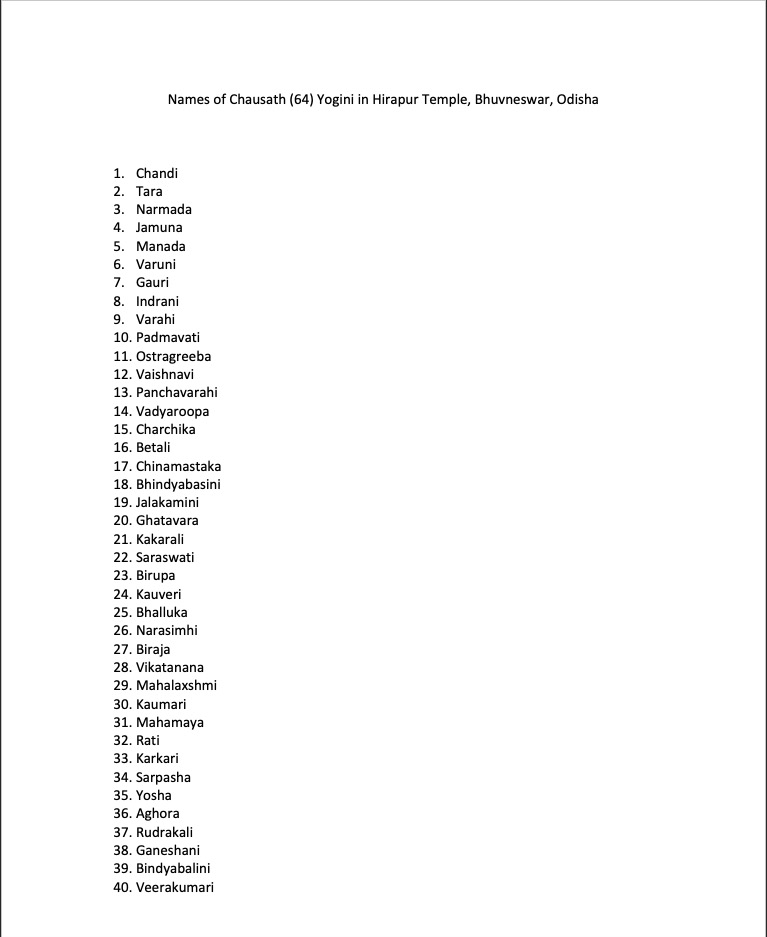
Source: Chausathi Yogini Temple

Chaunsath Yogini ( 64 योगिनी )
Jul 26 2019
In very ancient days, eight great Female Goddesses Shaktis emerged from the cosmic soul of the Principle Dieties and formed Kali Durga, the Universal Shakti Power, These were the grand Mothers (Ashta Matrikas) of all subsequent Yoginis. According to Kaula Tantra, these eight manifested each in turn into eight Divine Shaktis, thus resulting in the 64 Tantric Yoginis. These 64 powerful Goddesses have unique personas and powers to fulfill your desires, drive away negativity and fear, prevent misfortunes, and give you knowledge, peace, all-around prosperity, good progeny, and auspiciousness of all kinds.
An examination of the ancient Tantric tradition reveals a particular sanctity assigned to the number eight. The eight mother faculties (tatvas) of the manifested universe, the eight directions with four cardinal and four intermediate points (digbandahs), the eight miraculous yogic powers (siddhis), eight “limbs” of Yoga (astanga) eight forms of the Divine Mother (matrikas) and eight primary mystic symbols (mudras) are just a few examples. The square of eight, or sixty-four, occupies an even more profound position in the field of Tantra which, from the point of view of the practitioner, first and foremost identifies the sixty-four Tantric Yoginis.
Legends about the 64 Yoginis
The Lalitha Sahasranama and Vishnu Bhagavatha Purana reverently call the Divine Mother Shakti as Maha Yogini (Great Ascetic) and Kula Yogini. The Yogini Sahasranamaand Kaula Kularnava Tantra refers to the Supreme Devi as Maha Yogini. In ancient days, 8 great Female Shaktis emerged from the Universal Shakthi Energy called Parashakthi – these were the Divine Grand Mothers (called Ashta Matrikas) of all subsequent Yoginis. These 8 Matrikas manifested each in turn into Eight Sacred Shaktis, thus resulting in the 64 Tantric Yoginis.
The Yoginis are also popularly known and worshipped in Hinduism, Jainism and Buddhism in several countries as Bhairavis, Dhakinis, Shakinis, Sakinis, Sakthis, etc. The 64 Yoginis are known to be capable to manifest in physical form to give dharshan even in this Kali Yuga.
References about the 64 Yoginis and their powers can be found in the ancient scriptures like : Brahmananda Purana, Agni Purana, Skanda Purana, Kalika Purana, Jnanarnava Tantra, Brihad Nandikeswara Purana, Chandi Purana of Sarala Das, Brihndla Tantra, Bata Avakasa of Balaram Das, etc. Historical romances and semi-historical literature like Somadevasuri’s Yasastilaka of AD 959, Kalhana’s Rajatarangini of c.1150 and Somadeva’s Kathasarit Sagara of c.1070 contain legendary stories about the all-powerful Yoginis.
Names of 64 yoginis are as following:-
1. divyayoginī – दिव्ययोगिनी
2. mahāyoginī – महायोगिनी
3. siddhayoginī – सिद्धयोगिनी
4. gaṇeśvarī – गणेश्वरी
5. pretākṣī – प्रेताक्षी
6. ḍākinī – डाकिनी
7. kālī – काली
8. kālarātri – कालरात्रि
9. niśācarī – निशाचरी
10. jhaṃkārī – झंकारी
11. ūrdvavetālī – ऊर्द्ववेताली
12. kharparī – खर्परी
13. bhūtayāminī – भूतयामिनी
14. ūrdvakeśī – ऊर्द्वकेशी
15. virupākṣī – विरुपाक्षी
16. śuṣkaṃgī – शुष्कंगी
17. māṃsabhojanī – मांसभोजनी
18. phetkārī – फेत्कारी
19. vīrabhadrākṣī – वीरभद्राक्षी
20. dhūmrākṣī – धूम्राक्षी
21. kalahapriyā – कलहप्रिया
22. raktā – रक्ता
23. ghoraraktākṣī – घोररक्ताक्षी
24. piśacī – पिशची
25. bhayaṃkarī – भयंकरी
26. caurikā – चौरिका
27. mārikā – मारिका
28. caṇḍī – चण्डी
29. vārāhī – वाराही
30. muṇḍadhariṇī – मुण्डधरिणी
31. bhairavī – भैरवी
32. cakriṇī – चक्रिणी
33. krodhā – क्रोधा
34. durmukhī – दुर्मुखी
35. pretavāhinī – प्रेतवाहिनी
36. kaṇṭakī – कण्टकी
37. dīrghalaṃbauṣṭhī – दीर्घलंबौष्ठी
38. mālinī – मालिनी
39. mantrayoginī – मन्त्रयोगिनी
40. kālāgnī – कालाग्नी
41. mohinī – मोहिनी
42. cakrī – चक्री
43. kapālī – कपाली
44. bhuvaneśvarī – भुवनेश्वरी
45. kuṇḍalākṣī – कुण्डलाक्षी
46. juhī – जुही
47. lakṣmī – लक्ष्मी
48. yamadūtī – यमदूती
49. karālinī – करालिनी
50. kauśikī – कौशिकी
51. bhakṣiṇī – भक्षिणी
52. yakṣī – यक्षी
53. kaumārī – कौमारी
54. yantravahinī – यन्त्रवहिनी
55. viśālā – विशाला
56. kāmukī – कामुकी
57. vyāghrī – व्याघ्री
58. yākṣini – याक्षिनि
59. pretabhavanī – प्रेतभवनी
60. dhūrjaṭā – धूर्जटा
61. vikatā – विकता
62. ghorā – घोरा
63. kapālā – कपाला
64. laṅgalī – लङ्गलीMantra for Sri 64 Yogini yantra
oṁ aiṃ klīṃ śrīṃ hsauḥ catuḥṣaṣṭayoginebhyo namaḥ
Sapta Matrikas (Seven Mothers)
- Brahmaini
- Mahesvari
- Kaumari
- Vaisnavi
- Varahi
- Indrani
- Chamunda
Nav Durgas (Nine Devi)
- Shailaputri Devi
- White Color
- Brahmacharini Devi
- Red
- Chandraghanta Devi
- Royal Blue
- Kushmanda Devi
- Yellow
- Skandamata
- Green
- Katyayani Devi
- Grey
- Kalaratri Devi
- Orange
- Maha Gauri Devi
- Peacock Green
- Siddhidatri Devi
- Pink
Dasa (Ten) Mahavidyas
Each form of the Divine Mother Kali is a Mahavidya. Dasa Mahavidyas are:
- Kālī
- Tārā
- Ṣodaśī
- Bhuvaneśvarī
- Chinnamastā
- Bhairavī
- Dhūmāvatī
- Bagalāmukhī
- Mātangī
- Kamala
Shodashi (Sixteen) Nityas of Lalita
- Kamesvari
- Bhagamalini
- Nityaklinna
- Bherunda
- Vahnivasini
- Mahavajresvari
- Sivaduti
- Tvarita
- Kulasundari
- Nitya
- Nilapataka
- Vijaya
- Sarvamangala
- Jvalamalini
- Citra
- Mahanitya
Shodashi (Sixteen) names of Devi and 16 days worship Rituals
Source: The Millennium old 16-day Durga Puja in Odisha
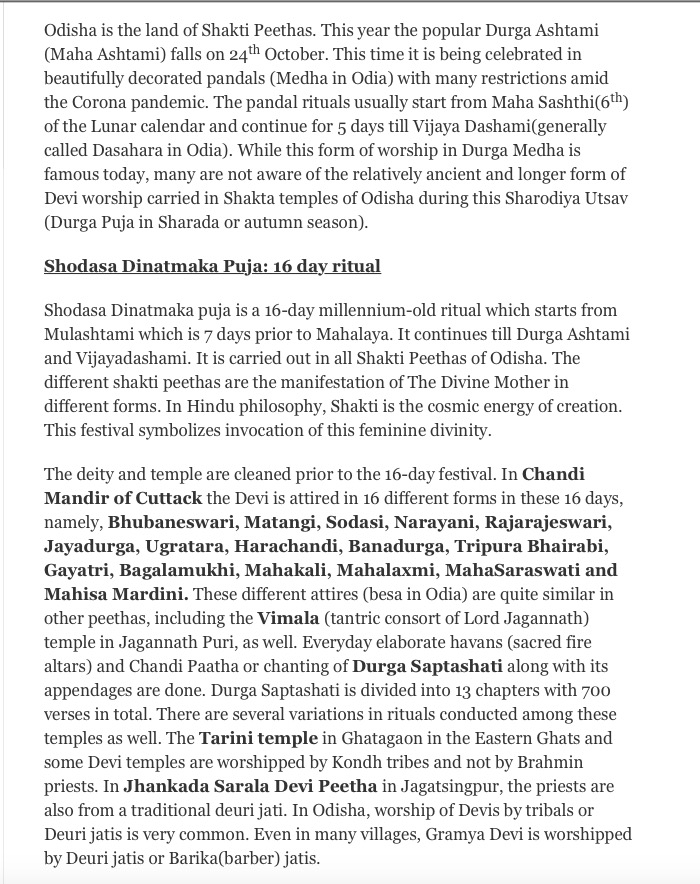
Source: The sixteen names of Durgā and their explanations
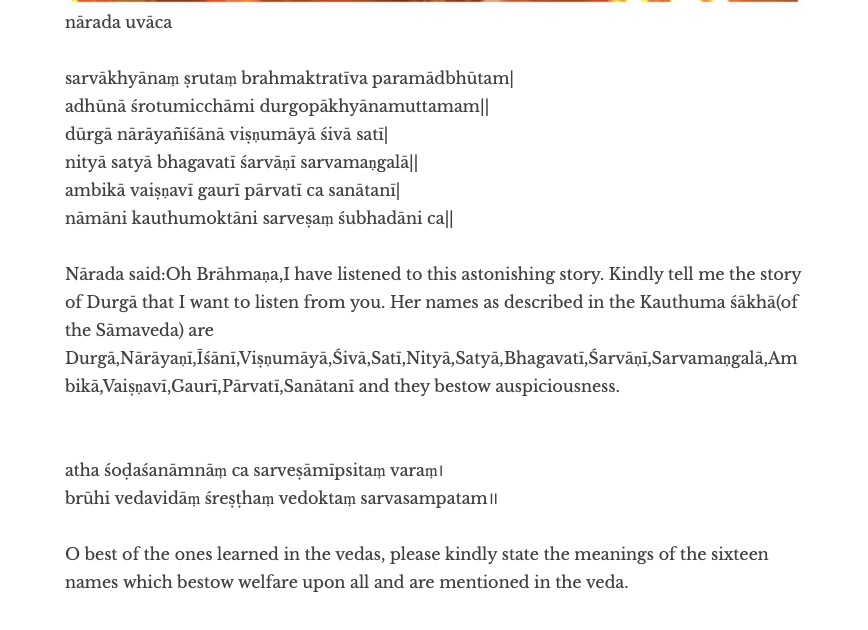
Chausath Yogini Temples in India
Source: When was Chousath Yogini Temple built?
There are 17 Chausath Yogini temples found across India out of which two are in Odisha, five in Madhya Pradesh, three in Uttar Pradesh, and one in Tamil Nadu. The most prominent ones are Hirapur, Ranipur Jharial, Khajuraho, Bhedaghat, Mitauli, Dudhai, and badoh. Several yogini temples have been lost, whether through deliberate destruction or plundering for building materials. Yogini images have been discovered from Shahdol, Hinglajgadh, Lokhari, Nareshwar, Rikhiyan, shahdol, Kanchipuram, greater Bengal, Varanasi, and Delhi.
Chausath Yogini Temple of Hirapur, also called Mahamaya Temple, is 20 km outside Bhubaneswar, the capital of Odisha state of Eastern India. It is devoted to the worship of the yoginis, auspicious goddess-like figures. The temple is believed to have been built by Queen Hiradevi of the Bramha dynasty during the 9th century. The temple is small and circular, only 25 feet in diameter. It is hypaethral and built of blocks of sandstone. The inside of the circular wall has niches, each housing the statue of a Goddess. 56 of the 64 idols, made of black stone, survive. They surround the main image at the center of the temple, the Goddess Kali
Chausath Yogini Temple of Ranipur Jharial in Balangir District, Odisha, The Chausath Yogini Temple, built in the 9th or 10th century in Ranipur-Jharial, in an isolated position some miles from the towns of Titilagarh and Kantabanjhi in Balangir district, Odisha, is a circular, hypaethral, 64-yogini temple made of sandstone, some 50 feet in diameter. 62 of the yogini images survive. The site, on an outcrop of rock, must have been important, given the presence of a large temple built of brick and several small temples of stone. The primary entrance is an opening in the circular wall towards the east; unlike at the Hirapur yogini temple, there was once a further opening towards the south, now filled in.
Chausath Yogini temple in Khajuraho town of Madhya Pradesh, India. Dated to the late 9th century, it is the oldest surviving temple at Khajuraho. According to an inscription dated to 1323 CE (Vikram Samvat 1383), the temple was built by the Kachchhapaghata king Devapala (1055 – 1075CE). It is said that the temple was the venue for providing education in astrology and mathematics based on the transit of the Sun. It is the earliest extant temple in the Chandela capital, Khajuraho. The temple is among the Western group of temples on a 5.4 m high platform. It has a rectangular plan measuring 31.4 m x 18.3 m. It is one of the historic Yogini temples across India; many of the others have a circular plan, though those at Rikhiyan and Badoh are also rectangular, so there was at least a local tradition of building them in this shape. Like all Yogini temples, the Khajuraho temple is hypaethral, open to the air. The temple is made of large, coarse granite blocks, with an open courtyard at the center. The centeryard was originally surrounded by 65 shrine cells: 10 on the front (north) wall, 11 on the back wall, and 22 on each side. Only 35 of these 65 cells now survive; each has a small doorway made of two squared granite pillars, a lintel stone, and a curvilinear tower roof. Above the lintel of the best-surviving cells is a triangular pediment. There is no surviving trace of a central shrine, whether to Shiva or the Goddess, as found in other Yogini temples.
Chausath Yogini Temple, Bhedaghat, also called the Golaki Math, is one of India’s yogini temples, but exceptionally it has shrines for 81 rather than the usual 64 yoginis. The temple is the largest of the circular yogini temples, some 125 feet in diameter. The scholar Shaman Hatley calls it the “most imposing and perhaps best known of the yogini temples”. It has a covered walkway with 81 cells for yoginis around the inside of its circular wall; three niches, two to the west, and one to the southeast remain open as entrances. There is a later shrine in the center of the courtyard; the temple was adapted as a Gauri-Shankar temple with the construction of the building in the south-centre of the circle in 1155 AD, at which time the central deities were moved. The temple was built early in the 11th Century AD by King Yuvaraja II, of the dynasty of the Kalachuris of Tripuri; he lived around 975-1025 AD
Chausath Yogini Temple, Mitaoli, also known as Ekattarso Mahadeva Temple, is an 11th-century temple in the Morena district in the Indian state of Madhya Pradesh. It is one of the few well-preserved Yogini temples in India. The temple is formed by a circular wall with 65 chambers, apparently for 64 yoginis and the goddess Devi, and an open mandapa in the center of a circular courtyard, sacred to Shiva. According to an inscription dated to 1323 CE (Vikram Samvat 1383), the temple was built by the Kachchhapaghata king Devapala (1055 – 1075CE). It is said that the temple was the venue for providing education in astrology and mathematics based on the transit of the Sun. The temple is on a hill about 100 feet (30 m) in height; there are 100 steps to climb up to the entrance. It is circular with a radius of 170 feet (52 m), while inside it has 65 small chambers, each with a mandapa which is open and a facia of pilasters and pillars. The roof of the ring of shrines is flat, as is that of the central shrine to Shiva; the circular courtyard is hypaethral, open to the sky, with an open porch as its entrance. The parliament building of India is said to have been based on this temple. The temple is in the Seismic Zone III region and has survived several earthquakes, seemingly without any serious damage. This fact was cited when the issue of safety from the earthquake effect of the circular Parliament House, its design supposedly based on the Mitaoli temple, was debated in the Indian Parliament.
Chausath Yogini Temple, Dudhai, Lalitpur, Uttarpradesh, details of temples are not available. The temple locally called as Akhada /Akhara, is situated in a forest of Buri Dudhai. Temple is believed to be built in the 10th century CE by Chandela kings. The temple is on a circular plan and has a hypaethral elevation. The temple is about 50 feet in diameter. The temple has 12 flat-roofed cells on the north, and five flat-roofed cells on the south, and the eastern and western portions are completely lost.
Chausath Yogini Temple, Badoh, Some 30 miles from Dudahi, at Badoh in Vidisha district, Madhya Pradesh is the Gadarmal temple of the Mothers, another 42-niche yogini temple, and one of the few that are rectangular. 18 broken images of the goddesses that once fitted into grooves in the temple platform are preserved from the waist down. It is composed of a rectangular shrine and a tall and massive Shikhara, adjacent to some Jain temples. Vidya Dehejia writes that the yogini temple must once have been hypaethral. Gadarmal Devi temple dates back to the 9th century. The architecture of this yogini temple is a fusion of Pratihara and Parmara styles.
Lokhari There appears to have been an early 10th-century yogini temple on a hilltop at Lokhari, Banda District, and Uttar Pradesh. A set of twenty images, nearly all theriomorphic, the figures having the heads of animals such as horse, cow, rabbit, snake, buffalo, goat, bear, and deer, has been recorded. Dehejia describes these as striking rather than specially artistic.
Nareshwar Another set of twenty 10th-century images, with careless later inscriptions from the 12th century, was rescued from Nareshwar (also called Naleshvar and Naresar) in Madhya Pradesh, a site which still has some twenty small Shaivite temples, to the Gwalior Museum, some fifteen miles away.
Hinglajgarh The site of Hinglajgarh, on the border of Madhya Pradesh and Rajasthan, was cleared of statuary for the building of the Gandhi Sagar Dam. The rescued statues contain enough fragments of yogini images for Dehejia to state that there was once a yogini temple at Hinglajgarh
Rikhiyan, Some 150 miles north of Khajuraho on the south bank of the River Yamuna, in the Banda District, Uttar Pradesh, are the fragmentary remains of what seems to have been a rectangular 64-Yogini temple in the Rikhiyan valley. This is part of a complex of other temples, unlike the solitary Yogini temples such as Mitaoli. When the site was photographed in 1909, ten four-Yogini slabs were present. Dehejia states that the multiples of 4 suggest a 64-Yogini total, while the straightness of the slabs implies a rectangular plan (as at Khajuraho). Seven were stolen on various occasions, and the last 3 of the slabs were moved to Gadhwa fort nearby for their safety. The slabs portray the Yoginis on a plain background without the usual attendant figures. They sit in the ceremonial pose of Lalitasana, one leg resting on their animal vehicle. They have “heavy breasts, broad waist[s] and large stomach[s]”. One has the head of a horse and holds a corpse, a severed head, a club, and a bell, and so maybe Hayanana, “The Horse-headed”. This and other Yoginis shown with corpses link the temple to a corpse ritual. Also photographed in 1909 were three three-Matrika slabs; Dehejia suggests that these formed part of a rectangular shrine to the Eight Matrikas accompanied by Ganesh. A well-preserved four-Yogini slab from Rikhiyan is held in the Denver Art Museum
Shahdol, Yogini images from Shahdol district (anciently Sahasa-dollaka) in Madhya Pradesh have been taken to the Dhubela Museum near Khajuraho, the Indian Museum at Calcutta, and the village temples of Antara and Panchgaon in Shahdol district. The yoginis are seated in the ceremonial Lalitasana pose, and they have haloes flanked by flying figures behind their heads
Kanchipuram or Kaveripakkam Dehejia publishes and discusses yogini images of the Chola period, around 900 AD, recovered from northern Tamil Nadu. These include one now in the British Museum, others in the Madras Museum, the Brooklyn Museum, the Minneapolis Institute of Arts, the Detroit Institute of Arts, and the Royal Ontario Museum. The British Museum yogini is ascribed to Kanchipuram; the collection site is not known, but many sculptures of the same style were recovered from a large “tank” (artificial lake) at Kaveripakkam, seemingly derived from nearby temples. The image formed part of a large set of yoginis.
Varanasi, 12th-century texts including the Varanasimahatmya of the Bhairavapradurbhava suggest that there was a circular hypaethral yogini temple in Varanasi (also called Benares and Kashi) in the 11th century. Several yogini-related sites have been identified in the city. Just above the Chaumsathi Ghat cremation ground is Chaumsathi Devi temple; it is not mentioned in the scriptures but is where modern-day devotees gather, especially at Holi, as prescribed in the Kashikhanda.
Delhi, Legend has it that a yogini temple was built in the south Delhi district of Mehrauli; tradition places this as the Yogmaya Temple there, without reliable evidence. The region outside the imperial city of Indraprastha, described in the Mahabharata, was called Yoginipura, the yogini city. Indraprastha has been identified with Delhi.
Source of Picture: Google
Chausath Yogini Temple, Bhedha Ghat, Jabalpur, MP, India
Source: Chausath Yogini Temple – Complete Inventory of Goddesses and Gods
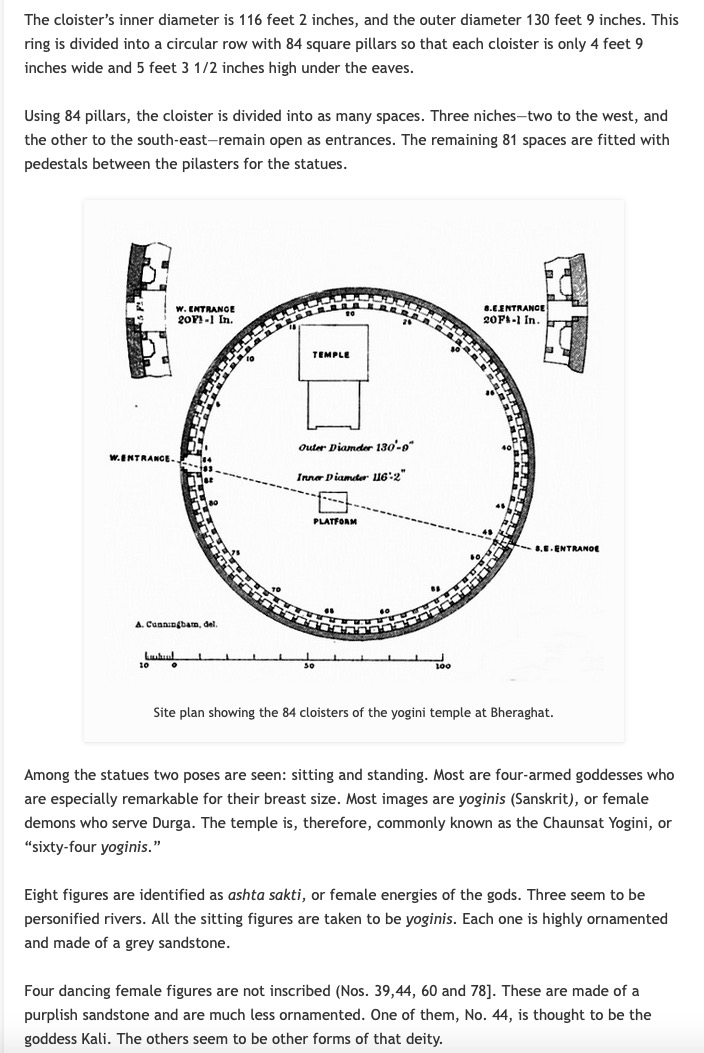
Source: Chausath Yogini Temple – Complete Inventory of Goddesses and Gods
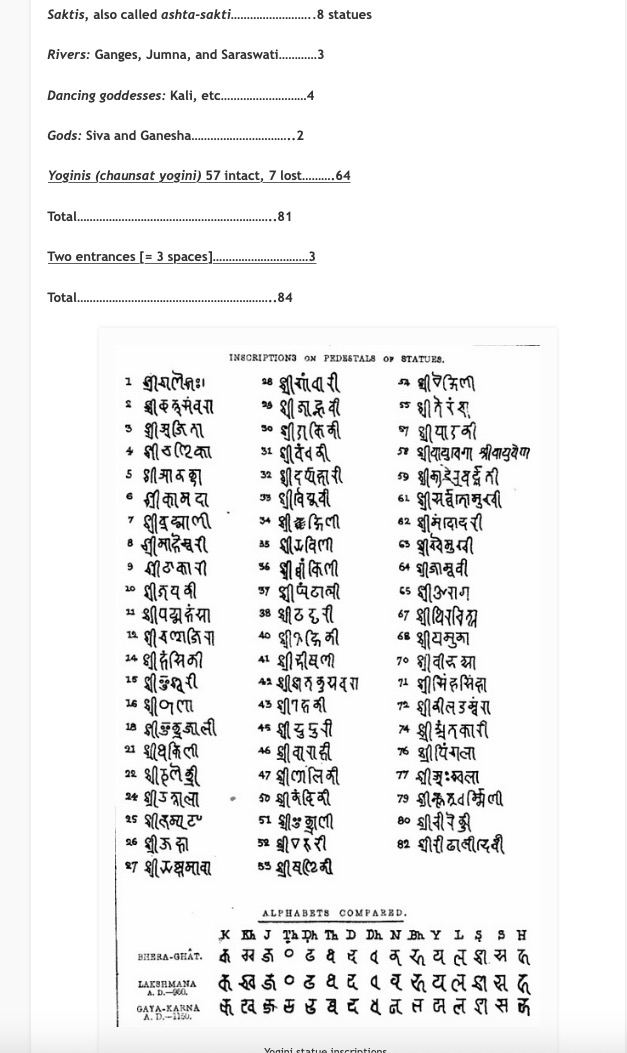
My Related Posts
Fractal Geometry and Hindu Temple Architecture
Consciousness of Cosmos: A Fractal, Recursive, Holographic Universe
Cantor Sets, Sierpinski Carpets, Menger Sponges
Sounds True: Speech, Language, and Communication
Rituals | Recursion | Mantras | Meaning : Language and Recursion
Key Sources of Research
The Intriguing Temples of the 64 Yoginis
Magik India
2022
Around Gwalior – The Chausath Yogini Temple at Mitavali
2016
https://www.awanderingmind.in/2016/08/around-gwalior-chausath-yogini-temple.html
Sixty-Four Yoginis
Dr Suruchi Pande
2019
https://www.esamskriti.com/e/Spirituality/Tantra/Sixty~Four-Yoginis–1.aspx
Chausath Jogini Mandir
Patra Tours
https://www.patratravels.com/tourist-places-in-odisha/bhubaneswar/yogini-temple.php
yoginis-and-bhairavas
In-depth analysis of the Cosmography of the Chausathi Yogini temple, Hirapur
Aparna Nambiar
2018
https://www.sahapedia.org/yoginis-and-bhairavas
Mothers, Lovers & Others: A study of the Chausathi Yogini Temple in Hirapur
Monalisa Behera
2018
https://www.sahapedia.org/mothers-lovers-others-study-of-the-chausathi-yogini-temple-hirapur
Women in Tantra: The Yoginis of Hirapur
Prateeq Kumar
2018
https://www.sahapedia.org/women-tantra-the-yoginis-of-hirapur
Chausath Yogini Temple, Dudhai Village, Lalitpur District, Uttar Pradesh
Lakshmi Subramanian
Sahasa
64 yogini Temple, Hirapur-A detailed view inside
by Sudhansu Nayak | Jan 10, 2009
64 yogini Temple, Hirapur-A detailed view inside
Chausath Yogini Varanasi
https://www.tourmyindia.com/states/uttarpradesh/chausath-yogini-temple-varanasi.html
Chausath Yogini Temple, Jabalpur: A Must Visit Heritage Site
By Nandni – August 6, 2013
Temple of 64 Yoginis of Hirapur
A beautiful Blog by Sudhansu Nayak
64 Yoginis of Hirapur, orissa- Introduction
Sudhansu Nayak
http://sudhansu-nayak.blogspot.com/2008/12/64-yoginis-of-hirapur-orissa.html
64 yogini Temple, Hirapur-A detailed view inside
Sudhansu Nayak
http://sudhansu-nayak.blogspot.com/2009/01/64-yogini-temple-hirapur-detailed-view.html#/
Chausath Yogini Temple, Madhya Pradesh
YOGINIS
Posted by Jayaraman | Dec 1, 2020
Chaunsath Yogini ( 64 योगिनी )
2019
https://www.devshoppe.com/en-us/blogs/articles/chaunsath-yogini-64
Khajuraho – Chausath Yogini Temple
BY KEVINSTANDAGEHOTOGRAPHY ON
Temple Architecture Styles part 9: 64 Yōginī Temples of India
Aditya Garg
Aug 8, 2020
The Goddess Hinghalaja of the Yogini Shrine at Khajuraho
Dr Devangana Desai
2013, ‘Yogini’ in South Asia
https://www.academia.edu/34913024/The_Goddess_Hinghalaja_of_the_Yogini_Shrine_at_Khajuraho
Rksamata – The Bear-Faced Yogini from Khajuraho
Dr Devangana Desai
2013, Bilvapatra, Treasures of Indian Art,
Dr. N. P. Joshi Felicitation Volume, Research India Press, Varanasi
https://www.academia.edu/34240885/Rksamata_The_Bear_Faced_Yogini_from_Khajuraho
Yoginis & Mātṝkās: Ecstatic Divine Celebration
Stella Dupuis
https://www.academia.edu/37765406/Yoginis_and_Mātṝkās_Ecstatic_Divine_Celebration
The Ancient Mythology and Iconography of the 64 Hindu Yoginis
Neha Mubeen
https://www.academia.edu/31119357/The_Ancient_Mythology_and_Iconography_of_the_64_Hindu_Yoginis
From Mātṛ to Yoginī: Continuity and Transformation in the South Asian Cults of the Mother Goddesses
Shaman Hatley
2012, Transformations and Transfer of Tantra in Asia and Beyond, ed. by István Keul (Walter de Gruyter)
From Mātṛgaṇa to Sapta Mātṛkās: Brahmanical Transformation of Autochthonous Goddesses,
Published 2011
The Memoirs of the Institute for Advanced Studies on Asia, no. 116, the University of Tokyo, 2011: 566-92.
Sacred Geography of Goddesses in South Asia. Essays in Memory of David Kinsley.
Singh, Rana P.B. (editor) 2010.
05 PeCu-10.
xviii + 396pp, 34 tables, 69 figures. ISBN (10): 1-4438-1865-8, ISBN (13): 978-1-4438-1865-0. Cambridge Scholars Publishing, Newcastle upon Tyne. U.K.
Yoginī, cult and temples : a tantric tradition
vidya dehejia
Book Published 1986
Chausath Yogini Temple Hirapur
March 12, 2021
Yogini Temples of India
Vidya Dehejia
Art International 1982 March April
Click to access Dehejia-Yogini-Temples-of-India-19821.pdf
When was Chousath Yogini Temple built?
Utkarsh Bitla
https://www.quora.com/When-was-Chousath-Yogini-Temple-built?top_ans=390322908
Chausath Yogini Temple, Mitaoli: A temple that celebrates the cult of powerful women
Its 64 chambers are dedicated to yoginis who worshipped Shiva
BY RIA GUPTA
6 February 2022
Chausath Yogini Temple
Bhedaghat, Jabalpur, Madhya Pradesh (MP)
August 26, 2015
Rangan Datta
The 64 Yogini Temples in astrogeography
Georg Stockhorst
September 12, 2018
The 64 Yogini Temples in astrogeography
ENIGMA OF THE TANTRIC MOTHERS: DARSHAN OF THE 64 YOGINI GODDESSES
64 Yogini Goddesses
December 22, 2014
By Swami Ayyappa Giri, Tantracharya, Yogini Ashram
THE ASHTA MATRIKAS
How the Ancient Mother Goddesses Elevate and Transform Consciousness
February 25, 2020
Chausath Yogini Temple, Mitaoli
Wikipedia
https://en.wikipedia.org/wiki/Chausath_Yogini_Temple,_Mitaoli
The Brahmayāmalatantra and early Śaiva cult of yoginīs
Hatley, Shaman.
University of Pennsylvania
ProQuest Dissertations Publishing, 2007. 3292099.
https://repository.upenn.edu/dissertations/AAI3292099/
Yogini temples
Wikipedia
https://en.wikipedia.org/wiki/Yogini_temples
Chausath Yogini Temple in Morena, Madhya Pradesh: 11th century inspiration for Indian Parliament?
Wild Films India
Ekattarso Mahadeva (Chausath Yogini) Temple – Mitaoli
BY KEVIN STANDAGE PHOTOGRAPHY ON APRIL 15, 2019 •
Shiva’s Temple Chausath Yogini District,Morena, India
Published 2013
https://www.academia.edu/43336460/Shivas_Temple_Chausath_Yogini_District_Morena_India
Hirapur: the Secret cult of Yoginis
LHI Team
https://www.peepultree.world/livehistoryindia/story/monuments/hirapur-the-secret-cult-of-yoginis
Chausath Yogini Temple Jabalpur
By Sanjeev Nayyar
Sanjeev@esamskriti.com
2017
https://www.esamskriti.com/a/Madhya-Pradesh/Chausath-Yogini-Temple-Jabalpur.aspx
Yoginis Temples of India: 42 Yogini Temple of Dudhai
Stella Yogini
Yogini Temples of India: Yogini Site of Kanchipuram
Stella Yogini
Regional Variations in Mātṛkā Conventions
Author(s): Michael W. Meister
Source: Artibus Asiae, Vol. 47, No. 3/4, (1986), pp. 233-262
Published by: Artibus Asiae Publishers
Stable URL: http://www.jstor.org/stable/3249973
Matrikas
Wikipedia
https://en.wikipedia.org/wiki/Matrikas
Tripura Sundari
Wikipedia
https://en.wikipedia.org/wiki/Tripura_Sundari
Matrikas – the Divine Mothers
Manish Jaishree
Saptamatrka – Part One – Devi
sreenivasarao’s blogs
The Portrait of the Goddess in the Devī-māhātmya
David Kinsley
Journal of the American Academy of Religion
Vol. 46, No. 4 (Dec., 1978), pp. 489-506 (18 pages)
Published By: Oxford University Press
https://www.jstor.org/stable/1463045
The 16 tithis and their details
Astrojyoti.com
https://www.astrojyoti.com/the-16-tithis-and-their-details.htm
Das Mahavidyas – The 10 Tantric Goddesses of Wisdom
Written By Swami Ayyappa Giri
Kriya Tantra Institute
https://kriyatantrainstitute.com/articles/mahavidyasadhana
Goddess Worship in Hinduism: The Ten Wisdom Goddesses of Shaktism
Aishwarya Javalgekar
2012
https://www.academia.edu/32388291/Goddess_Worship_in_Hinduism_The_Ten_Wisdom_Goddesses_of_Shaktism
Dus Mahavidyas – the Ten Forms of the Devi
Ganesh Kumar
https://www.academia.edu/5923232/Dus_Mahavidyas_the_Ten_Forms_of_the_Devi
Ten Mahavidyas-Manifestations Of Cosmic Female Energy
Exotic India
2010, Exotic India Art
https://www.academia.edu/50890236/Ten_Mahavidyas_Manifestations_Of_Cosmic_Female_Energy
The 64 Yoginis
https://www.academia.edu/36586087/The_64_Yoginis
SAPTAMATRIKAS – LEGENDS, HISTORY, ICONOGRAPHY AND TEMPLES
By Anuradha Goyal – October 12, 2020
Wisdom Goddesses – Mahavidyas and the Assertion of Femininity in Indian Thought
May 2002
Nitin Kumar Editor http://www.exoticindia.com
https://www.exoticindiaart.com/article/mahavidyas/
Worship of the Goddess in Hinduism
Sarah Caldwell, Harvard Divinity School
Sponsored by 25th Anniversary Conference of the Sri Venkateswara Temple in Pittsburgh, 2000
https://www.infinityfoundation.com/mandala/i_es/i_es_caldw_goddess_frameset.htm
The Millennium old 16-day Durga Puja in Odisha
Odisha is the land of Shakti Peethas and while people mainly associate Durga Puja with West Bengal, Odisha has its own unique celebration.
OCTOBER 24, 2020 | BY: ABHISEK KUMAR PANDA
The Great Goddess Lalita And The Sri Chakra
by Subhash Kak– Oct 1, 2016
Swarajya
https://swarajyamag.com/culture/the-great-goddess-lalita-and-the-sri-chakra
The Great Goddess Devi
Smithsonian Magazine
June 1999
https://www.smithsonianmag.com/history/the-great-goddess-devi-68120189/
The sixteen names of Durgā and their explanations
(from the 57th adhyaya of the Brahmavaivarta Purāṇa)
Posted on 27/06/2020 by abhinnah_api
The Tantric Goddess
https://www.worldhistory.biz/sundries/43558-the-tantric-goddess.html
About Mahavidya The 10 Forms of Goddess Shakti | Adi Parashakti
https://templesinindiainfo.com/about-mahavidya-the-10-forms-of-goddess-shakti/
Devi Ambā: The Goddess with the Lion
Subhash Kak
Feb 12, 2019
https://subhashkak.medium.com/devi-ambā-the-goddess-with-the-lion-513f80dfc70
64 Yogini Temple in Hirapur, Odisha
Chausathi Yogini Temple
Chausath Yogini Temple – Complete Inventory of Goddesses and Gods
Kent Davis
March 5, 2010
Chausath Yogini Temple – Complete Inventory of Goddesses and Gods
The 81 Yoginis of Bhedhaghat
Divya Deswal
Kiss of the Yogini by David Gordon White
Book Review
Kent Davis
February 13, 2009
Kiss of the Yogini by David Gordon White Book Review
Sakti (Shakti) Cult in Orissa
AUTHOR: FRANCESCO BRIGHENTI
PUBLISHER: D. K. PRINTWORLD PVT. LTD.
LANGUAGE: ENGLISH
EDITION: 2001
ISBN: 8124601798
https://www.exoticindiaart.com/book/details/sakti-shakti-cult-in-orissa-idd202/
Chausath Yogini Temple of Jabalpur: A Historical Survey
International Research Journal Commerce arts science
2019, isara solutions
https://doi.org/10.32804/CASIRJ
Publication Date: 2019
https://www.academia.edu/44483911/Chausath_Yogini_Temple_of_Jabalpur_A_Historical_Survey
Additional References
Source: Wikipedia
- Das, Adyasha (2019). The Chausathi Yoginis of Hirapur : from tantra to tourism. Bhubaneswar: Black Eagle Books. ISBN 978-1-64560-012-1. OCLC 1200743540.
- Dehejia, Vidya (1986). Yogini Cult and Temples: A Tantric Tradition. National Museum, Janpath, New Delhi.
- Donaldson, Thomas Eugene (2002). Tantra and Sakta Art of Orissa. New Delhi: D. K. Printworld. ISBN 978-8124601990.
- Dupuis, Stella (2008). The Yoginī Temples of India : in the pursuit of a mystery, travel notes. Varanasi: Pilgrims Publishing. ISBN 978-81-7769-665-3. OCLC 298129207.
- Hatley, Shaman (2007). The Brahmayāmalatantra and Early Śaiva Cult of Yoginīs. University of Pennsylvania (PhD Thesis, UMI Number: 3292099).
- Hatley, Shaman (2014). “11: Goddesses in Text and Stone : Temples of the Yoginis in Light of Tantric and Puranic Literature”. In Benjamin Fleming; Richard Mann (eds.). Material Culture and Asian Religions: Text, Image, Object. Routledge. pp. 195–226. ISBN 978-1138546141.
- Kaimal, Padma Audrey (2012). Scattered Goddesses: Travels with the Yoginis. Association for Asian Studies. ISBN 978-0-924304-67-5.
- Keul, István (2012). “Blending into the Religious Landscape: The Yoginīs in Benares”. Numen. Brill. 59 (4): 366–402. doi:10.1163/156852712×641796. ISSN 0029-5973. JSTOR 23244944.
- Roy, Anamika (2015). Sixty-four Yoginis : cult, icons and goddesses. Delhi: Primus Books. ISBN 978-93-84082-12-3. OCLC 919909942.
- White, David Gordon (2006) [2003]. Kiss of the Yogini: ‘Tantric Sex’ in its South Asian Contexts. University of Chicago Press. ISBN 978-0226894843.
References
Source: Yoginis and Bhairavs
Dehejia, V. 1986. Yoginī Cult and Temples: A Tantric Tradition. New Delhi: National Museum.
Donaldson, Thomas E. 1985. Hindu Temple Art of Orissa 3 vols. Leiden: Brill.
Gadon, Elinor. ‘Probing the Mysteries of the Hirapur Yoginis’. In ReVision Vol. 25, no. 1 (2002): 33-41.
Shaw, Miranda. 1994. Passionate Enlightenment: Women in Tantric Buddhism. New Jersey: Princeton University Press.
Mahapatra, K. N. 1953. ‘A Note on the Hypaethral Temple of Sixty-four Yoginis at Hirapur,’ Orissa Historical Research Journal II: 23–40; reprinted in H. K. Mahtab, ed., Orissa Historical Research Journal, Special Volume, 1982.
Hatley, Shaman. 2007. ‘The Brahmayamalatantra and Early Saiva Cult of Yoginis’. Unpublished PhD. dissertation, University of Pennsylvania.
Stietencron, Henrich von. 2013. ‘Cosmographic buildings of India: The circles of the yogini,’ Yogini in South Asia: Interdisciplinary Approaches (Routledge Studies in Asian Religion and Philosophy), ed. István Keul, pp. 70-83. London: Routledge.
Further readings
Hatley, Shaman. ‘Matr to Yogini: Continuity and Transformations in the cult of the Mother Goddesses,’ in Transformations and Transfer of Tantra in Asia and Beyond, edited by István Keul, pp. 99–129, Berlin: Walter de Gruyter, 2012.
Mishra, P.B. Orissa under the Bhauma Kings. Calcutta: Vishwamitra Press, 1934.
Panigrahi, K. C. Archaeological Remains at Bhubaneswar. Bombay: Orient Longmans, 1961.
Sharma, Rajkumar. The Temple of Chaunsatha-yogini at Bheraghat. Delhi: Agam Kala Prakashan, 1978.
